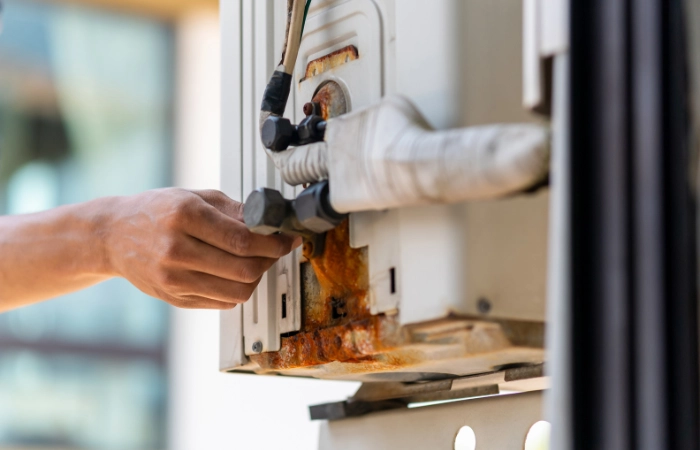Is your home air conditioner blowing warm air or leaking water? A clogged AC drain line could be the culprit! A clogged drain line prevents condensate (water) produced during cooling from draining properly. This can lead to a number of problems, including reduced cooling efficiency, mold growth, and even water damage to your home. In this guide, we’ll walk you through 7 steps on how to fix clogged AC drain lines to get your air conditioner back up and running in no time.
Causes of Clogged AC Drain Line
Clogged AC drain lines can create significant issues, leading to inefficiencies and potential damage to your air conditioning system. Understanding the common causes of these clogs can help you avoid future issues and maintain the optimal performance of your AC unit. Here are some of the typical culprits:
- Dirt and debris
- Algae and mold growth
- Sludge buildup
- Rust and mineral deposits
- Installation issues
- Poor maintenance
Signs Your AC Drain Line Is Clogged
A clogged AC drain line can disrupt your comfort and potentially lead to more serious problems. By recognizing the warning signs, you can address the issue promptly and prevent costly repairs. Here’s a breakdown of the signs that your AC drain line might be clogged:
1. Water Leaks
The most direct sign of a clogged AC drain line is water leaking around the air conditioning unit. This usually happens when the drain pan inside the air handler overflows due to water being unable to exit through the clogged drain line.
2. Unusual Noises
If you notice gurgling or bubbling sounds near your AC unit, it might be due to water struggling to pass through a blockage in the drain line. These noises can occur when air is trapped and is pushed through the liquid by the draining process.
3. Musty Smells
A persistent musty odor emanating from your AC unit could indicate stagnant water in the drain pan or line, often due to a clog. This stagnant water can become a breeding ground for mold and mildew, contributing to the unpleasant smell.
4. Visible Mold or Algae
Visible signs of mold or algae around the drain line exit or indoor unit are a clear indicator of moisture problems, typically arising from poor drainage. This can often be seen as greenish-black or white growths near moisture-heavy areas.
5. Reduced AC Efficiency
If your AC doesn’t cool your space as effectively, or if there is increased humidity in your home, it might be due to a clogged drain affecting the system’s overall efficiency. When the drain line is clogged, the humidity levels in the air handler are not properly managed, which can lead to less effective cooling.
6. Safety Switch Activation
Many modern air conditioners include a safety switch that automatically shuts off the unit if the drain line backs up to prevent water damage. If your AC unexpectedly turns off, this safety feature may have been triggered by a clog.
What You’ll Need to Unclog Your AC Drain Line
Before you can start the process of clearing your AC drain line, it’s important to gather all the necessary tools and materials to ensure the job can be done effectively and safely. Here’s what you’ll typically need to address how to fix clogged AC drain lines:
- Wet/Dry Vacuum
- Vinegar or Cleaning Solution
- Rigid Wire or Plumber’s Snake
- Gloves and Safety Goggles
- Bucket
7 Steps to Fix a Clogged AC Drain Line
A clogged AC drain line can cause significant problems for your home’s cooling system, but with the right approach, it can be swiftly and efficiently resolved. Here are seven steps on how to fix clogged AC drain lines:
1. Turn Off the Power
Prioritize safety by switching off all power to the AC unit system at the circuit breaker or fuse box. This prevents any electrical shocks or accidents while you’re working on the system.
2. Locate and Inspect the Drain Line
Identify the AC drain line, typically a PVC pipe extending from your indoor air handler to an outside area. Visually inspect the line for any obvious signs of damage like cracks or splits and pinpoint any areas where clogs might occur, usually at bends or connections.
3. Prepare Your Tools
Ready your cleaning arsenal, which should include a wet/dry vacuum designed for handling liquids, a plumber’s snake for dislodging stubborn clogs, and protective gloves to keep your hands clean and safe from irritants.
4. Vacuum the Clog
Attach the hose of your wet/dry vacuum to the drain line using an adapter to guarantee a tight seal. Turn on the vacuum to extract the debris that’s blocking the line. This method is particularly effective because it pulls the clog out rather than pushing it further into the pipe.
5. Use Vinegar or Cleaning Solution
After removing the physical blockage, rinse the drain line with a solution of vinegar and water or a non-corrosive cleaning product. This will help break down any biological growth and flush out residues that the vacuum might have missed.
6. Check the Drain Flow
To ensure the line is clear, pour water into either the drain pan or directly into the drain line. Watch how quickly it drains; any hesitation or backup means there might still be a partial blockage.
7. Restore Power and Monitor the AC
Once you’re satisfied that the drain is clear, restore power to the unit and turn on the AC. Monitor the system to ensure it’s operating normally with no signs of leaking or overflowing from the drain pan. If the clog persists, it may be wise to seek professional assistance on how to fix clogged AC drain lines.
FAQs on How to Fix Clogged AC Drain Line

How often should I clean my AC drain line?
It’s recommended to clean your AC drain line at least once a year to ensure it remains clear of blockages and operates efficiently. If you live in a high-humidity area or an environment with lots of dust and pollen, you might need to clean the drain line more frequently, possibly every few months.
Can you use bleach to clean drain pipes?
While it’s possible to use bleach for this purpose, it’s not recommended. Bleach can efficiently eliminate mold and bacteria; however, it can also corrode certain materials and pose environmental hazards if not handled responsibly.
How can I prevent my AC drain line from clogging?
Regular maintenance is key to preventing clogs. This includes routine cleaning of the drain line, changing air filters regularly to reduce the amount of debris entering the system, and scheduling annual inspections with a professional to ensure the entire system is in good working order.
Conclusion
Knowing how to fix clogged AC drain lines can save you significant time and money while keeping your home comfortable and your AC operating efficiently. With these seven easy steps, you can often resolve minor clogs on your own.
However, if you encounter a more complex issue, don’t hesitate to contact Tropic Air Conditioning Inc. Our professionals are ready to assist with any AC problems you might face. Remember, regular maintenance is the best way to avoid a clogged AC drain line and guarantee your unit operates at peak efficiency. Contact us!




